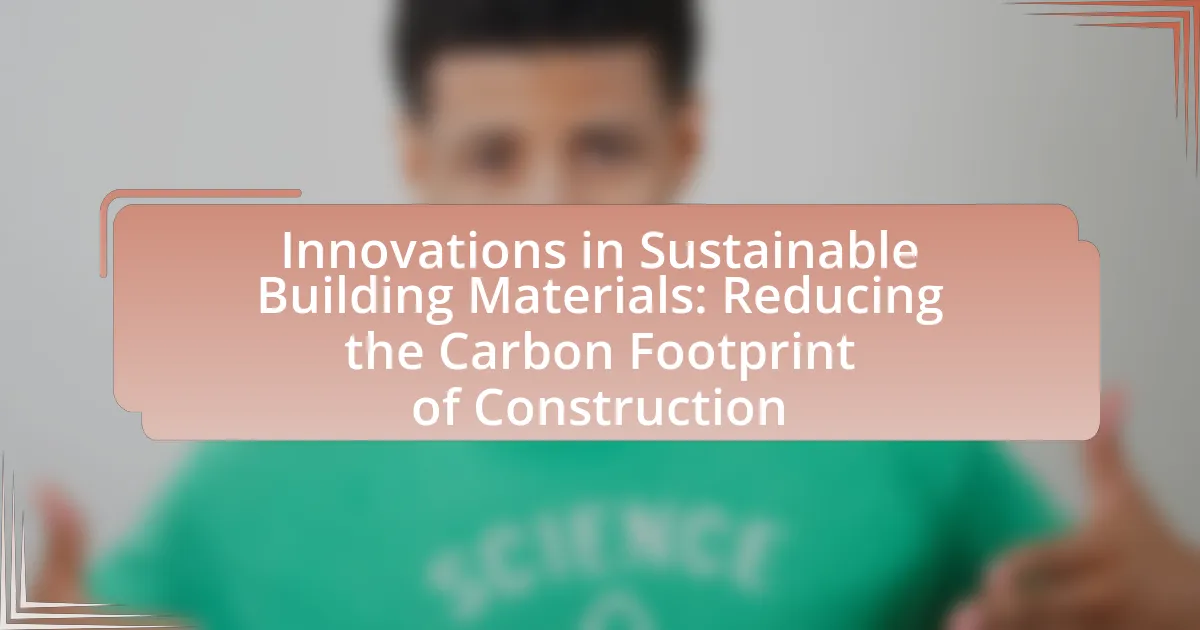The article focuses on innovations in sustainable building materials and their role in reducing the carbon footprint of construction. It highlights various materials such as cross-laminated timber, recycled steel, and bio-based composites, which significantly lower greenhouse gas emissions by utilizing renewable resources and minimizing waste. The discussion includes the environmental impacts of conventional construction practices, the benefits of sustainable materials, and the latest trends driven by technology and research. Additionally, it addresses the challenges faced in adopting these materials, including economic barriers and regulatory issues, while emphasizing the importance of stakeholder engagement and government incentives in promoting sustainability in the construction industry.

What are Innovations in Sustainable Building Materials?
Innovations in sustainable building materials include the development of products such as cross-laminated timber, recycled steel, and bio-based composites. These materials significantly reduce the carbon footprint of construction by utilizing renewable resources and minimizing waste. For instance, cross-laminated timber sequesters carbon dioxide during its growth and can replace more carbon-intensive materials like concrete and steel, which are responsible for a substantial portion of global greenhouse gas emissions. Additionally, recycled steel reduces the need for virgin materials and energy consumption in production, while bio-based composites, made from natural fibers and resins, offer a sustainable alternative to traditional plastics. These innovations are supported by research indicating that sustainable materials can lower overall emissions in the construction industry by up to 30%.
How do these innovations contribute to reducing the carbon footprint?
Innovations in sustainable building materials significantly reduce the carbon footprint by utilizing renewable resources and enhancing energy efficiency. For instance, materials like bamboo and recycled steel require less energy to produce compared to traditional materials, leading to lower greenhouse gas emissions during manufacturing. Additionally, innovations such as carbon capture technology in concrete production can reduce emissions by up to 30%, as reported by the Global Cement and Concrete Association. These advancements not only minimize the environmental impact during construction but also promote long-term sustainability through improved insulation and energy performance in buildings, further decreasing operational carbon emissions.
What specific materials are considered sustainable in construction?
Sustainable materials in construction include bamboo, recycled steel, reclaimed wood, and rammed earth. Bamboo is a fast-growing plant that sequesters carbon and can be harvested sustainably. Recycled steel reduces the need for new steel production, which is energy-intensive, and can be reused multiple times without losing strength. Reclaimed wood repurposes existing timber, minimizing waste and preserving forests. Rammed earth utilizes natural soil, which has low embodied energy and provides excellent thermal mass. These materials contribute to reducing the carbon footprint of construction by minimizing resource extraction and energy consumption.
How do these materials compare to traditional building materials?
Innovative sustainable building materials generally offer lower environmental impact compared to traditional building materials. For instance, materials like bamboo and recycled steel have a significantly reduced carbon footprint, with bamboo sequestering carbon during its growth and recycled steel requiring less energy to produce than new steel. Additionally, sustainable materials often enhance energy efficiency, as seen in the use of insulated concrete forms, which can reduce heating and cooling costs by up to 50% compared to conventional materials. These advantages highlight the growing preference for sustainable options in modern construction practices.
Why is sustainability important in the construction industry?
Sustainability is important in the construction industry because it significantly reduces environmental impact and promotes resource efficiency. The construction sector is responsible for approximately 39% of global carbon emissions, highlighting the urgent need for sustainable practices to mitigate climate change. Implementing sustainable building materials and methods can lower energy consumption, minimize waste, and enhance the longevity of structures. For instance, using recycled materials can decrease the demand for new resources, while energy-efficient designs can reduce operational costs and emissions over time.
What are the environmental impacts of conventional construction practices?
Conventional construction practices significantly contribute to environmental degradation through high carbon emissions, resource depletion, and waste generation. The construction industry is responsible for approximately 39% of global carbon emissions, primarily due to the energy-intensive processes involved in producing materials like cement and steel. Additionally, conventional practices often lead to the depletion of natural resources, as they rely heavily on non-renewable materials and generate substantial waste, with about one-third of all waste produced globally coming from construction activities. These impacts highlight the urgent need for sustainable alternatives in building practices to mitigate environmental harm.
How does sustainable building address these impacts?
Sustainable building addresses environmental impacts by utilizing materials and practices that minimize resource consumption and reduce carbon emissions. For instance, the use of recycled materials, such as reclaimed wood and recycled steel, significantly lowers the demand for new resources and decreases waste. Additionally, sustainable buildings often incorporate energy-efficient systems, such as solar panels and high-performance insulation, which reduce energy consumption and greenhouse gas emissions during operation. According to the U.S. Green Building Council, buildings that achieve LEED certification can reduce energy use by 30% to 50% compared to conventional buildings, demonstrating the effectiveness of sustainable practices in mitigating environmental impacts.

What are the latest trends in sustainable building materials?
The latest trends in sustainable building materials include the increased use of recycled materials, biobased products, and innovative low-carbon alternatives. Recycled materials, such as reclaimed wood and recycled steel, are gaining popularity due to their ability to reduce waste and lower the carbon footprint of construction. Biobased products, including bamboo and hempcrete, are being utilized for their renewability and lower environmental impact. Additionally, advancements in low-carbon concrete, such as geopolymer concrete, are emerging as effective alternatives to traditional cement, which is responsible for a significant portion of global CO2 emissions. These trends reflect a growing commitment to sustainability in the construction industry, driven by both regulatory pressures and consumer demand for environmentally friendly building practices.
How are technology and innovation shaping these trends?
Technology and innovation are significantly shaping trends in sustainable building materials by enabling the development of eco-friendly alternatives that reduce the carbon footprint of construction. Advanced materials such as cross-laminated timber and recycled concrete are being engineered to enhance durability while minimizing environmental impact. For instance, the use of 3D printing technology in construction allows for precise material usage, reducing waste by up to 30% compared to traditional methods. Additionally, innovations in insulation materials, like aerogels, provide superior thermal performance, leading to lower energy consumption in buildings. These advancements are supported by research from the International Energy Agency, which highlights that sustainable materials can cut greenhouse gas emissions in the construction sector by 50% by 2030.
What role does research and development play in material innovation?
Research and development (R&D) is crucial for material innovation as it drives the discovery and optimization of new materials that enhance sustainability in construction. R&D enables the exploration of alternative materials, such as bio-based composites and recycled products, which can significantly reduce the carbon footprint associated with traditional building materials. For instance, studies have shown that the use of recycled concrete can lower greenhouse gas emissions by up to 50% compared to conventional concrete. Additionally, R&D facilitates the improvement of material properties, such as durability and energy efficiency, which are essential for sustainable building practices. Through systematic experimentation and analysis, R&D not only fosters innovation but also ensures that new materials meet regulatory standards and performance criteria, thereby advancing the overall sustainability of the construction industry.
How are manufacturers adapting to sustainability demands?
Manufacturers are adapting to sustainability demands by integrating eco-friendly materials and processes into their production lines. For instance, many manufacturers are now utilizing recycled materials, such as reclaimed wood and recycled plastics, to create building products, which significantly reduces waste and lowers the carbon footprint associated with new material extraction. Additionally, manufacturers are investing in energy-efficient technologies and renewable energy sources to power their operations, further minimizing environmental impact. According to a report by the World Green Building Council, buildings account for 39% of global carbon emissions, prompting manufacturers to innovate in sustainable practices to meet regulatory standards and consumer expectations for greener products.
What are some examples of innovative sustainable materials?
Some examples of innovative sustainable materials include bamboo, recycled steel, and mycelium. Bamboo is a fast-growing plant that sequesters carbon and can be used for structural applications due to its strength and flexibility. Recycled steel reduces the need for new raw materials and energy consumption, as it can be repurposed from existing structures. Mycelium, the root structure of fungi, can be grown into biodegradable composites that serve as insulation or packaging, significantly lowering environmental impact. These materials contribute to reducing the carbon footprint of construction by utilizing renewable resources and minimizing waste.
How is recycled content being utilized in new materials?
Recycled content is utilized in new materials primarily through the incorporation of reclaimed plastics, metals, and glass into construction products. For instance, recycled polyethylene terephthalate (rPET) is used in insulation and roofing materials, while recycled steel is commonly integrated into structural components. According to the U.S. Environmental Protection Agency, using recycled materials can reduce energy consumption by up to 60% compared to using virgin materials. This practice not only conserves resources but also significantly lowers greenhouse gas emissions associated with material production, aligning with sustainable building goals.
What are the benefits of using bio-based materials in construction?
Bio-based materials in construction offer significant benefits, including reduced environmental impact, improved energy efficiency, and enhanced indoor air quality. These materials, derived from renewable resources, contribute to lower carbon emissions compared to traditional materials like concrete and steel. For instance, using bamboo or hemp can sequester carbon during their growth, effectively offsetting emissions during their lifecycle. Additionally, bio-based materials often require less energy to produce, leading to a smaller carbon footprint. Studies have shown that buildings constructed with bio-based materials can improve indoor air quality by reducing volatile organic compounds, promoting healthier living environments.

What challenges do sustainable building materials face?
Sustainable building materials face challenges such as higher initial costs, limited availability, and performance concerns. Higher initial costs can deter builders and developers from choosing sustainable options, as traditional materials often appear more economically viable upfront. Limited availability of sustainable materials can restrict their use in various regions, making it difficult for construction projects to source them consistently. Performance concerns arise when sustainable materials do not meet the same durability or efficiency standards as conventional materials, leading to skepticism among builders and consumers. These challenges hinder the widespread adoption of sustainable building materials despite their environmental benefits.
How do cost and availability impact the adoption of these materials?
Cost and availability significantly influence the adoption of sustainable building materials. High costs can deter builders and developers from selecting these materials, as they often seek to minimize expenses while maximizing profit margins. For instance, a study by the National Institute of Standards and Technology found that the initial cost of sustainable materials can be 10-20% higher than conventional options, which can lead to reluctance in their adoption. Additionally, limited availability of these materials in certain regions can further hinder their use, as construction projects require reliable access to resources. According to the U.S. Green Building Council, regions with a robust supply chain for sustainable materials see a 30% higher adoption rate compared to areas with limited access. Thus, both cost and availability are critical factors that shape the market dynamics for sustainable building materials.
What are the economic barriers to using sustainable materials?
The economic barriers to using sustainable materials include higher initial costs, limited availability, and lack of market demand. Higher initial costs arise because sustainable materials often require advanced technologies or processes that are more expensive than conventional materials. Limited availability is a barrier as many sustainable materials are not produced at scale, making them harder to source and increasing costs. Additionally, the lack of market demand for sustainable materials can lead to reduced investment in their production, perpetuating a cycle of higher prices and limited options. According to a report by the World Economic Forum, the upfront costs of sustainable building materials can be 10-20% higher than traditional options, which discourages widespread adoption despite long-term savings and environmental benefits.
How can these barriers be overcome?
Barriers in sustainable building materials can be overcome through increased investment in research and development, which leads to the creation of more efficient and cost-effective materials. For instance, the development of bio-based materials and recycled content can significantly reduce carbon emissions associated with traditional construction materials. A study by the World Green Building Council indicates that using sustainable materials can lower the carbon footprint of buildings by up to 40%. Additionally, implementing government incentives for sustainable practices encourages manufacturers and builders to adopt innovative materials. This combination of technological advancement and supportive policies creates a conducive environment for overcoming barriers in sustainable construction.
What regulatory and certification challenges exist?
Regulatory and certification challenges in sustainable building materials include the lack of standardized guidelines and varying regional regulations. These inconsistencies can hinder the adoption of innovative materials, as manufacturers must navigate a complex landscape of compliance requirements. For instance, the absence of universally accepted sustainability metrics complicates the certification process, leading to delays and increased costs for developers. Additionally, some regions may impose stringent environmental regulations that do not align with the capabilities of new materials, creating barriers to market entry. This situation is evidenced by the differing certification standards set by organizations such as LEED and BREEAM, which can confuse stakeholders and slow down project timelines.
How do building codes affect the use of sustainable materials?
Building codes significantly influence the use of sustainable materials by establishing minimum standards for safety, performance, and environmental impact in construction. These regulations can either promote or hinder the adoption of sustainable materials depending on how they are written and enforced. For instance, codes that incentivize energy efficiency and the use of recycled materials encourage builders to incorporate sustainable options, while restrictive codes may limit innovative materials that do not meet traditional standards. In the United States, the International Green Construction Code (IgCC) provides guidelines that support the use of sustainable materials, demonstrating how building codes can facilitate environmentally friendly practices in construction.
What certifications are important for sustainable building materials?
Important certifications for sustainable building materials include LEED (Leadership in Energy and Environmental Design), BREEAM (Building Research Establishment Environmental Assessment Method), and FSC (Forest Stewardship Council) certification. LEED evaluates the environmental performance of a building and encourages market transformation towards sustainable design, while BREEAM assesses the sustainability of buildings in various categories, including energy use and health. FSC certification ensures that wood products come from responsibly managed forests, promoting sustainable forestry practices. These certifications are recognized globally and provide a framework for assessing the sustainability of building materials, thereby supporting efforts to reduce the carbon footprint of construction.

How can stakeholders promote the use of sustainable building materials?
Stakeholders can promote the use of sustainable building materials by implementing policies that incentivize their adoption and by providing education on their benefits. For instance, government entities can offer tax credits or grants for projects that utilize eco-friendly materials, thereby encouraging builders to choose sustainable options. Additionally, industry organizations can conduct workshops and seminars to inform architects, contractors, and developers about the long-term cost savings and environmental advantages of sustainable materials, such as reduced energy consumption and lower carbon emissions. Research indicates that buildings constructed with sustainable materials can reduce energy use by up to 30%, demonstrating the tangible benefits of such practices.
What strategies can architects and builders implement?
Architects and builders can implement strategies such as utilizing sustainable materials, optimizing energy efficiency, and incorporating modular construction techniques. Sustainable materials, like bamboo and recycled steel, significantly reduce the carbon footprint of buildings by minimizing resource extraction and waste. Energy-efficient designs, including passive solar heating and high-performance insulation, lower energy consumption and greenhouse gas emissions. Modular construction techniques streamline the building process, reduce waste, and enhance resource efficiency, as evidenced by studies showing that modular buildings can reduce construction waste by up to 90%. These strategies collectively contribute to more sustainable construction practices.
How can education and awareness improve material choices?
Education and awareness can significantly improve material choices by equipping individuals and professionals with knowledge about sustainable options and their environmental impacts. When stakeholders in construction understand the benefits of using eco-friendly materials, such as reduced carbon emissions and enhanced energy efficiency, they are more likely to select these alternatives over traditional materials. Research indicates that informed decision-making can lead to a 30% reduction in carbon footprint when sustainable materials are prioritized in building projects. This shift not only promotes environmental sustainability but also encourages innovation in the development of new materials that further minimize ecological harm.
What role do government incentives play in promoting sustainability?
Government incentives play a crucial role in promoting sustainability by encouraging businesses and individuals to adopt environmentally friendly practices. These incentives, such as tax credits, grants, and subsidies, lower the financial barriers associated with implementing sustainable technologies and practices. For instance, the U.S. federal government offers a tax credit for solar energy installations, which has significantly increased the adoption of solar panels across the country. According to the Solar Energy Industries Association, the U.S. solar market grew by 167% from 2010 to 2020, largely due to such incentives. By making sustainable options more economically viable, government incentives drive innovation and investment in sustainable building materials, ultimately contributing to a reduction in the carbon footprint of construction.
What best practices should be followed when selecting sustainable materials?
When selecting sustainable materials, prioritize materials that are renewable, recyclable, and have low environmental impact. This includes choosing materials sourced from sustainable practices, such as bamboo or reclaimed wood, which reduce deforestation and promote biodiversity. Additionally, consider the lifecycle assessment of materials to evaluate their total environmental impact from extraction to disposal. For instance, concrete alternatives like hempcrete or recycled steel significantly lower carbon emissions compared to traditional concrete. Furthermore, verify certifications such as LEED or FSC, which ensure adherence to sustainability standards. These practices collectively contribute to reducing the carbon footprint of construction projects.
How can lifecycle assessments guide material selection?
Lifecycle assessments (LCAs) guide material selection by evaluating the environmental impacts of materials throughout their entire life cycle, from extraction to disposal. By quantifying factors such as energy consumption, greenhouse gas emissions, and resource depletion, LCAs enable decision-makers to identify materials that minimize negative environmental effects. For instance, a study published in the Journal of Cleaner Production found that using recycled materials can significantly reduce carbon emissions compared to virgin materials, thus supporting more sustainable choices in construction. This data-driven approach ensures that material selection aligns with sustainability goals, ultimately contributing to a reduced carbon footprint in building projects.
What are the key considerations for integrating sustainable materials into projects?
Key considerations for integrating sustainable materials into projects include assessing the lifecycle impact, ensuring material availability, and evaluating performance standards. Lifecycle impact analysis helps determine the environmental effects of materials from extraction to disposal, which is crucial for minimizing carbon footprints. Material availability ensures that sustainable options can be sourced reliably, preventing project delays. Performance standards must be met to guarantee that sustainable materials provide the necessary durability and functionality, as evidenced by studies showing that high-performance sustainable materials can reduce energy consumption by up to 30% in buildings.


